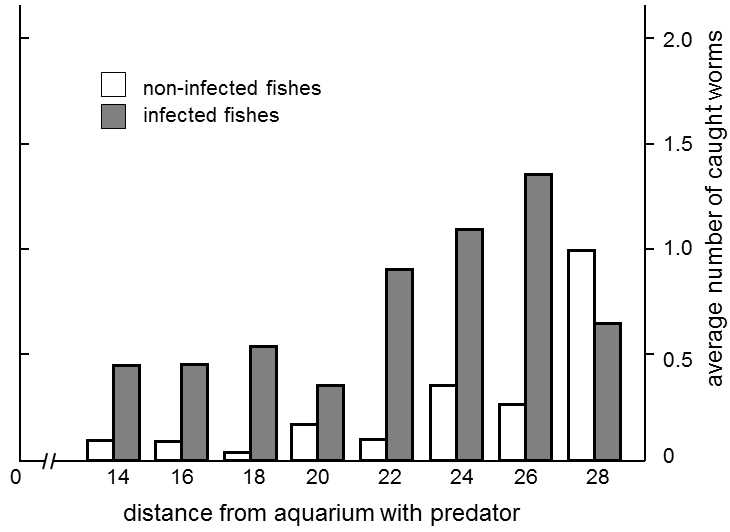XIX.6.5.2 Manipulation of a host’s behavior by parasites transmitted through predation has been demonstrated in many systems
Spreading by predation is a frequent means of transmission of a parasite. In this type of transmission, the host is infected by eating prey infected by the parasite.The parasite can increase the probability that an individual that it infects will be caught, for example, by increasing its activity (Brown et al. 1994; Webster 1994; Hay et al. 1984; Hay et al. 1986) or shifting this activity to a different time of day, for example from nighttime to daytime, or by reducing the escape reaction of its host, either by prolonging its reaction time or by reducing its fear of danger or of unknown stimuli (Hutchison, Aitken, & Wells 1980; Hay et al. 1983; Hay, Aitken, & Graham 1984) (Fig.. XIX.14).In some cases, the parasite modifies

Fig. XIX.14 Reduction of the fear of predators in an infected host. The graph depicts the result of an experiment in which a pair of sticklebacks (Gasterosteus), one healthy and one infected by the tapeworm Schistocephalus solidus, placed in an aquarium with food (sludge worms) located at various distances from a glass wall, on the other side of which was located a predaceous cichlid. A study was made of the number of worms the infected and healthy fish picked up and the distance from the wall beyond which the cichlid was located. It is apparent that the infected sticklebacks were “braver” and collected the food much more frequently, even close to the predator. It is quite possible that, in this case, the parasite does not affect the nervous system of the host directly, but rather indirectly – infected sticklebacks are hungrier. According to Milinski (1990).
the escape reaction of its host in a way such that this reaction tends to increase, rather than decrease the probability that the intermediate host will be caught by the definitive host.A well-known example consists of acanthors of the Polymorphus genus, which force their intermediate host, fresh water shrimp of the Gammarus genus, to react to disturbance by escaping to the water surface (if the definitive host is a nondiving duck) or movement along the bottom (if the host of this species is a diving duck) (Barnard & Behnke 1990; Minchella 1985).
